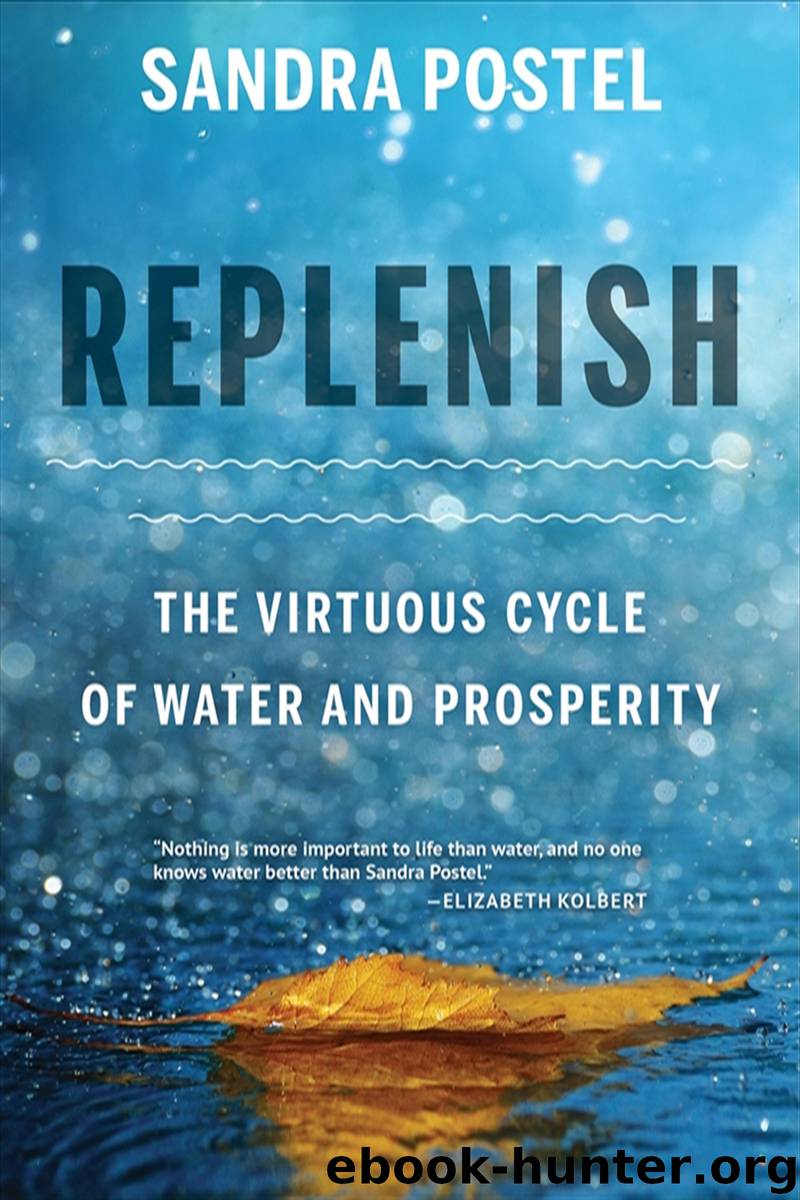Replenish: The Virtuous Cycle of Water and Prosperity by Sandra Postel

Author:Sandra Postel
Language: eng
Format: epub
Publisher: Island Press
When a haunting phrase like dead zone appears in news headlines every year like clockwork, something is terribly wrong. But each spring, typically early to mid-June, a press release goes out from NOAA announcing the predicted size of the coming dead zone—a band of water with dangerously low oxygen levels—that will form that summer in the Gulf of Mexico off the southern US coastline. The Gulf’s dead zone is the second largest in the global ocean, after that in northern Europe’s Baltic Sea. Over the last decade, it has averaged more than 5,600 square miles (14,500 kilometers), an area roughly the size of Connecticut. It typically extends from near shore to about 75 miles (120 kilometers) into the Gulf, and from the Mississippi River west across the Louisiana shelf to Texas.
As on Long Island, an influx of nutrients into the Gulf—mostly nitro- gen, but phosphorus, as well—fuels the growth of algae, which then decompose and deplete the water of oxygen. While finfish and other swimmers may migrate to better-quality water, other species may die. As the ecosystem declines, so do the shrimp, crab, and fish harvests and the jobs that depend on them. In 2011 the Gulf’s commercial and recreational fisheries yielded a dockside value of $818 million and generated 23 million recreational fishing trips.17
Like a giant funnel, the vast watershed of the Mississippi River, which spans 41 percent of the continental United States, collects runoff from as far west as Montana and as far east as Pennsylvania, and moves it through a network of rivers and streams that converge in Louisiana and then empty into the Gulf of Mexico. As with any river that reaches the sea, the Mississippi’s delivery of nutrients and sediment from the continental interior to the coast is a natural and important part of the hydrologic cycle; it is essential to the health of the Mississippi Delta and the marine environment. What is neither natural nor healthy is the volume of nutrients now pouring into the Gulf. Over the last half century, as the American heartland transformed from a landscape of native prairies, forests, and wetlands to croplands and cities, water not only began to flow off the land more quickly, increasing the risk of flooding, it began to carry heavy loads of nitrogen and phosphorus, especially from farm fertilizers. Today, agriculture contributes 80 percent of the nitrogen and more than 60 percent of the phosphorus delivered to the Gulf.18
In 1997, more than a decade after scientists began to document the scale of the problem, US federal and state agencies formed the Hypoxia Task Force to curb the nutrient load in the Mississippi River basin. In 2001 the task force set a goal of reducing the size of the dead zone to less than 5,000 square kilometers (1,930 square miles) by 2015. Then, early in 2015, the collaborative announced that it would take until 2035—an extra two decades—to achieve that goal. Reaching it would require at least a 45 percent reduction in the loads of both nitrogen and phosphorus flowing into the Gulf.
Download
This site does not store any files on its server. We only index and link to content provided by other sites. Please contact the content providers to delete copyright contents if any and email us, we'll remove relevant links or contents immediately.
| Anthropology | Archaeology |
| Philosophy | Politics & Government |
| Social Sciences | Sociology |
| Women's Studies |
The Secret History by Donna Tartt(18159)
The Social Justice Warrior Handbook by Lisa De Pasquale(11951)
Thirteen Reasons Why by Jay Asher(8451)
This Is How You Lose Her by Junot Diaz(6435)
Weapons of Math Destruction by Cathy O'Neil(5829)
Zero to One by Peter Thiel(5488)
Beartown by Fredrik Backman(5356)
The Myth of the Strong Leader by Archie Brown(5237)
The Fire Next Time by James Baldwin(5016)
How Democracies Die by Steven Levitsky & Daniel Ziblatt(4954)
Promise Me, Dad by Joe Biden(4908)
Stone's Rules by Roger Stone(4857)
100 Deadly Skills by Clint Emerson(4690)
A Higher Loyalty: Truth, Lies, and Leadership by James Comey(4550)
Rise and Kill First by Ronen Bergman(4545)
Secrecy World by Jake Bernstein(4388)
The David Icke Guide to the Global Conspiracy (and how to end it) by David Icke(4380)
The Farm by Tom Rob Smith(4323)
The Doomsday Machine by Daniel Ellsberg(4245)
